OTHER RESOURCES
Some of this information comes from the archives of the San Diego Aerospace Museum (SDAM).
---o0o---
THANK YOU!
YOUR PURCHASE OF THESE BOOKS SUPPORTS THE WEB SITES THAT BRING TO YOU THE HISTORY BEHIND OLD AIRFIELD REGISTERS
Your copy of the Davis-Monthan Airfield Register with all the pilots' signatures and helpful cross-references to pilots and their aircraft is available at the link. 375 pages with black & white photographs and extensive tables
---o0o---
The Congress of Ghosts (available as eBook) is an anniversary celebration for 2010. It is an historical biography, that celebrates the 5th year online of www.dmairfield.org and the 10th year of effort on the project dedicated to analyze and exhibit the history embodied in the Register of the Davis-Monthan Airfield, Tucson, AZ. This book includes over thirty people, aircraft and events that swirled through Tucson between 1925 and 1936. It includes across 277 pages previously unpublished photographs and texts, and facsimiles of personal letters, diaries and military orders. Order your copy at the link.
---o0o---
Military Aircraft of the Davis Monthan Register, 1925-1936 is available at the link. This book describes and illustrates with black & white photographs the majority of military aircraft that landed at the Davis-Monthan Airfield between 1925 and 1936. The book includes biographies of some of the pilots who flew the aircraft to Tucson as well as extensive listings of all the pilots and airplanes. Use this FORM to order a copy signed by the author, while supplies last.
---o0o---
Art Goebel's Own Story by Art Goebel (edited by G.W. Hyatt) is written in language that expands for us his life as a Golden Age aviation entrepreneur, who used his aviation exploits to build a business around his passion. Available as a free download at the link.
---o0o---
Winners' Viewpoints: The Great 1927 Trans-Pacific Dole Race (available as eBook) is available at the link. This book describes and illustrates with black & white photographs the majority of military aircraft that landed at the Davis-Monthan Airfield between 1925 and 1936. The book includes biographies of some of the pilots who flew the aircraft to Tucson as well as extensive listings of all the pilots and airplanes. Use this FORM to order a copy signed by the author, while supplies last.
---o0o---
Clover Field: The first Century of Aviation in the Golden State (available in paperback) With the 100th anniversary in 2017 of the use of Clover Field as a place to land aircraft in Santa Monica, this book celebrates that use by exploring some of the people and aircraft that made the airport great. 281 pages, black & white photographs.
---o0o---
The definitive reference for early Lockheed aircraft is:
Allen, Richard S. 1988. Revolution in the Sky: The Lockheeds of Aviation's Golden Age. Orion Books, NY. 253 pp.
---o0o---
YOU CAN HELP
I'm looking for information and photographs of pilot Mantz and his airplanes to include on this page. If you have some you'd like to share, please click this FORM to contact me.
---o0o---
SPONSORED LINKS
PLEASE HELP KEEP THESE WEB SITES ONLINE
FOR YOUR CONVENIENCE
You may NOW donate via PAYPAL by clicking the "Donate" icon below and using your credit card. You may use your card or your PAYPAL account. You are not required to have a PAYPAL account to donate.
Or you can scan the QR code below with your mobile device and be linked to your PayPal app.
 |
|---|
Either way, when your donation clears the PAYPAL system, a certified receipt from Delta Mike Airfield, Inc. will be emailed to you for your tax purposes.
---o0o---
ALBERT PAUL MANTZ
"I'm not a stunt pilot. I'm a precision pilot."
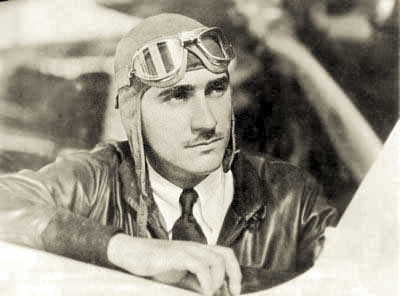 |
Paul Mantz was born August 2, 1903 at Alameda, CA. He died tragically on July 8, 1965 at Imperial Valley, CA. During his 61 years he became a very well-known aviator-entrepreneur on the west coast during the 1920s-1960s. During his career, he signed the Clover Field Register twice, the Peterson Field (CO) Register once, and the Albuquerque (NM) Register twice.
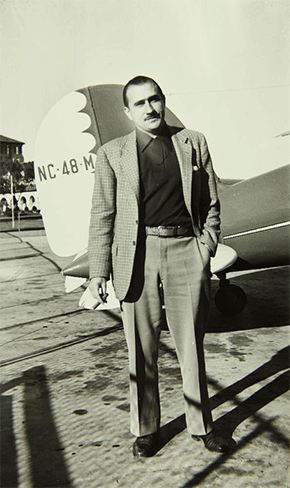 |
For our purposes here, he signed the Santa Monica Register first on Saturday, February 23, 1929 at 2:00PM. He arrived at Santa Monica from Mills Field, San Francisco, CA. He was solo in NC6432, a Stearman C-3B, S/N 139. He entered as his destination his return to Mills Field, but did not leave us a departure time. An interesting article appeared in Sport Aviation, June, 1939 (PDF 108kB). It describes Mantz's experiences flying a Stearman in 1928 over the same Los Angeles to San Francisco route.
 |
The next time we find him signed at Santa Monica was six years later on Thursday, August 15, 1935. This time he flew NC48M, a Lockheed Vega, S/N 100. The undated photograph at right is from the SDAM Flickr Stream and shows Mantz with cigar in front of NC48M. This was the same airplane he flew to Albuquerque in 1934 and 1935. He listed no arrival or departure places or times. The owner of the airplane written in the Register was illegible, although we know from this REFERENCE that it was owned by Mantz from 1933-38. Given his decades-long flying presence in the Los Angeles area, he probably landed at Clover Field many more times, but did not take the time to sign the Register.
U.S. Census information for Mantz is complete through 1940. The 1910 U.S. Census, his first, placed him at age 6 living in Alameda with his family, father Robert W. (age 42), mother Annie (42) sister Ruth (14) and brother Robert (8). Also living with them was a boarder, Cornelia Walker (64), who was single and lived on her "Own Income." His father was a "Dean" at a "California College." His mother was a college teacher. Interestingly, Mantz's grandparents were born in Germany, making him a second generation American.
The 1920 Census placed him in San Mateo, CA at age 16 living with his mother, now widowed (age 52), sister Ruth (23) and brother Robert (17). His mother was a listed as a public school teacher.Photograph, above left, shows him at age 18 from a family-maintained wabsite which was inoperable as of 01/08/23. At age 26, the 1930 Census identified his address as San Mateo. His occupation was listed as "Aviator" in the "Aviation" industry. He was single and living in an apartment that cost him $55 per month.
Mantz learned to fly in the U.S. Army, but was discharged just before his graduation in 1927 for reckless flying. It seems he buzzed a passenger train full of high-ranking Army officers who were on their way to attend the graduation ceremonies. Around 1929, he went into air charter work with the motto "Anywhere-Anytime." He established United Air Services, Ltd. at United Airport, Burbank, CA. His promise was for as good or better service than the commercial airlines, in a hurry, and for a reasonable price. This attitude and ethic brought him a lot of business, such that he was successful even as the Great Depression took hold and deepened.
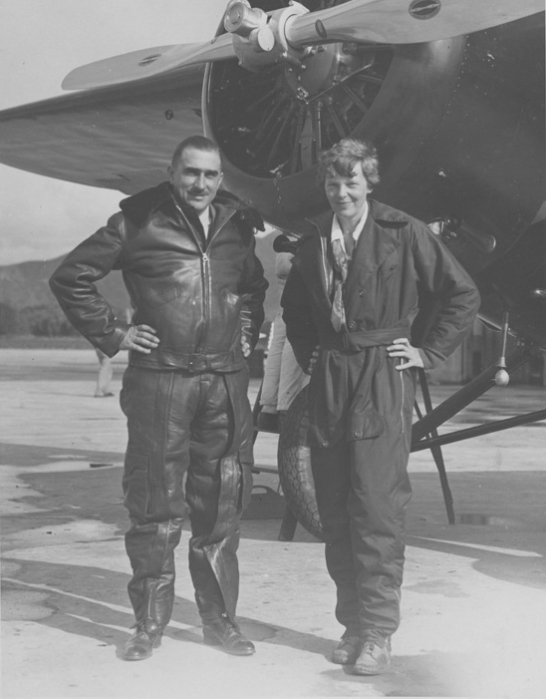 |
From my reading on the subject, I believe the Stearman NC6432 was probably his first airplane in service of United Air Services, and his flight to and from San Francisco might have been one of his charters. Soon, however, he had five aircraft flying on charter, forest patrol, student training and exhibitions. Further to the Stearman, he wrote an article for Popular Aviation magazine (PDF 108kB), June, 1939, that described an experience in this airplane over the same route.
He also entered the motion picture business. Early on, he flew stunts in various movies and in 1932 he flew for Register pilot Howard Hughes in "Air Mail." In that film he flew NC448W, a Curtiss-Wright 15-N/Travel Air, S/N 15N-2002, through a hangar open on both ends, with only five feet of clearance on each side for his wings. Thanks to a tip from a site visitor, you can view this flight in "Air Mail" at the link. The link takes you to the approximate location of his through-the-hangar flight.
His willingness to do such precision flights was not the only virtue that was attractive to movie studios. He provided readily-available aircraft and pilots, standard rates, and insurance to protect producers from the financial risks of accidents and downtime. He was successful, and more precision flight business came to him and his staff. In this way, Mantz became very wealthy from the 1930s onward. He was the go-to resource for aerial movie shoots.
Mantz's contributions to the motion picture industry were summarized in the following undated resumé I found at the SDAM. It lists the films made with the cooperation Paul Mantz Air Services, the motion picture arm of Mantz's United Air Services. Although ths prolific list is undated, it does place "For Whom the Bell Tolls" as "in production." That movie was released in 1943, so the list antedates that. Notice "Anywhere-Anytime" at the bottom of this document.
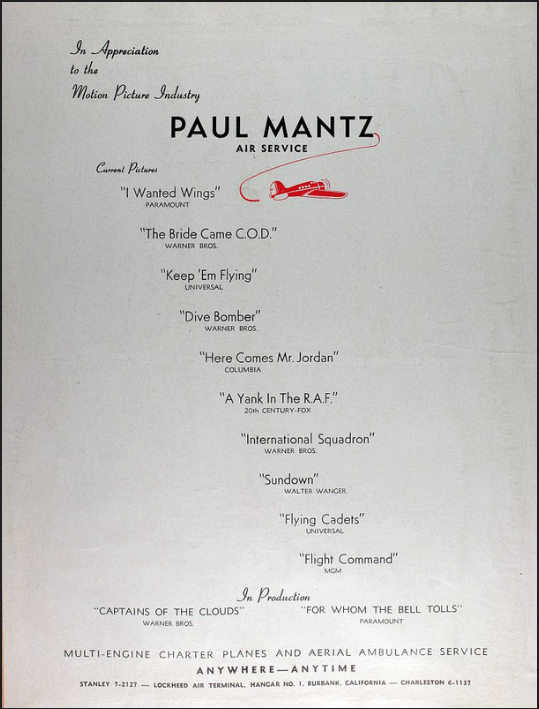 |
His work with "Dive Bomber" was documented by The New York Times, June 1, 1941, below. Notice his innovations in camera mounting and technicolor photography.
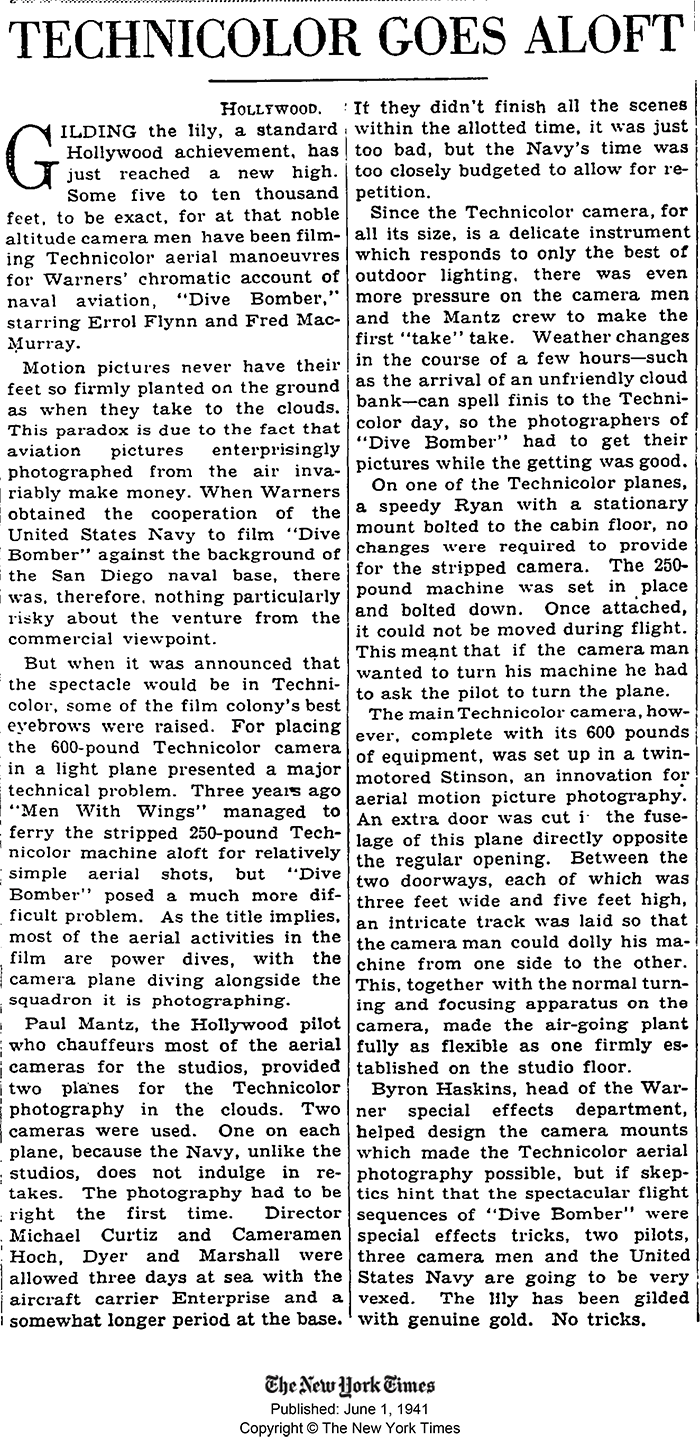 |
His work can be seen in other, later films such as ‘Twelve O'Clock High' in 1949; ‘Around the World in Eighty Days' in 1956; and ‘It's a Mad Mad Mad Mad World' in 1963.
 |
Mantz was married twice. First, in 1932, to Myrtle L. "Red" Harvey, left. She was one of his flying students. They divorced in 1936.
After their divorce, he was dating Terry Minor, the widow of friend and fellow Register pilot Roy Minor, who had died in 1935. Mantz married Theresa Mae Minor (Nee: Blair; b. August 1, 1905; d. April 1, 2006) on August 19, 1937. Mantz adopted the Minor's two children, Roy and Terita. Their son, Albert Paul Mantz, Jr., was born on August 21, 1938. Roy Mantz later became a naval aviator. Below, Mantz and Terry on their wedding day.
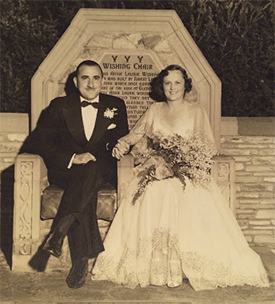 |
Another of Mantz's famous students and acquaintances was Amelia Earhart, pictured in the large photo above. Later, he also was a technical adviser for her planned around-the-world flight in 1937.
Mantz was also alleged to have had an affair with Earhart. I could find no hard data to support that allegation. Earhart was named co-respondent in Mantz's 1936 divorce, and the evidence around the allegation was circumstantial at best. The nature of the "evidence" was listed, below, in the February 29, 1936 issue of the Los Angeles Examiner. This article was pasted in a scrapbook belonging to Register pilot Mary Charles that I discovered at the National Air & Space Museum (NASM). The NASM call number for the Charles files is at her link.
 |
Likewise, the July 27, 1936 issue of the Reno Evening Gazette (NV) stated, "There was testimony that Mrs. Mantz was jealous of Miss Earhart, but Mantz took the stand and denied there was any basis for such an attitude." A similar statement appeared in The New York TImes (NYT) of July 28, 1936, which also expanded upon the grounds for the divorce (alleged cruelty by Mantz; unreasonable jealousy false accusations by Myrtle).
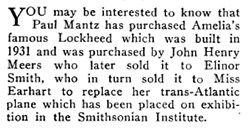 |
Earlier, in 1935, Mantz allegedly purchased Earhart's Lockheed Vega NR965Y. A short article in Popular Aviation (PA) magazine, June, 1935, right, suggests the transaction. However, in the Allen reference in the left sidebar, there is no record of Mantz owning the airplane. Both the alleged affair and the alleged purchase of Earhart's airplane are just that, alleged.
 |
Five years later, in 1940, Mantz suffered an automobile accident, right, that left him with severe injuries. Exact date and news source unidentified. The 1940 Census placed Mantz at age 35 living at 10080 Valley Spring Lane in Los Angeles. According to Google Earth, this address today is a large, tile roof, private home abutting a golf course with swimming pool, two-car garage and other accoutrements of a luxury home. According to the Census, it was valued at $35,000 in 1940. Mantz lived there with Theresa and her two children, Roy (12) and Tenita (8) who now shared his last hame. As well, Paul, Jr. (2) shared the household, as did Carloa Acazara (19) who was identified as their "Servant."
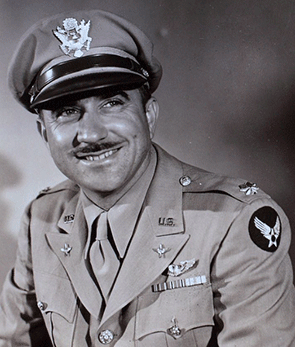 |
As WWII approached, Mantz helped with the arming of Great Britain by ferrying new Lockheed bombers from the factory in Burbank, CA to New York's Floyd Bennett Field. The airplanes were then disassembled and transported by ship to England (NYT, November 12, 1939).
During World War II, Mantz served in the Army Air Corps' Motion Picture Unit. His team produced both training films and documentaries about military aviation. He headed up the “Culver City Commandos” of the First Motion Picture Unit, a group whose ranks included Clark Gable, Van Heflin, Alan Ladd, George Montgomery, and Ronald Reagan.He developed several innovations to improve aerial photography, many of which he applied to his post-war career when he increasingly added aerial director of photography to his credits. Portrait, left, courtesy of SDAM, is from WWII. He was discharged in 1944 as a lieutenant colonel.
After the war, life was good for the Mantz family during the late 1940s and beyond. A U.S. Immigration form recorded Theresa and daughter Tenita returning to the U.S. from Hawaii on December 26, 1946 aboard the S.S. Matsonia. Mantz, on the other hand, according to another U.S. immigration form available on ancestry.com, flew the route commercially from Hawaii on NC88859, a Pan American Lockheed L-149 Constellation, S/N 2059, named "Clipper Flying Eagle."
His continued successes in moving pictures amassed for him a fortune over the years estimated at $10 million. In 1946, he purchased 475 surplus bombers and fighters for $55,000. He sold the majority for scrap. He also made a tidy profit selling just the aviation gasoline left in the fuel tanks. He kept three of the aircraft for himself; two P-51 Mustangs and a B-25 Mitchell bomber.
The bomber was outfitted with a refrigerator and toilet and was used as executive transport for his company, and for air-to-air filming through a specially constructed Plexiglas nose. During the 1950s, it was used to mount three massive 35-mm cameras used to film aerial scenes for widescreen Cinerama movies. He continued to use his B-25 in his motion picture business for the rest of his life.
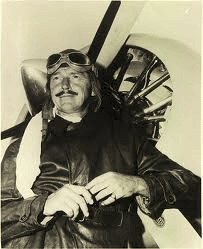 |
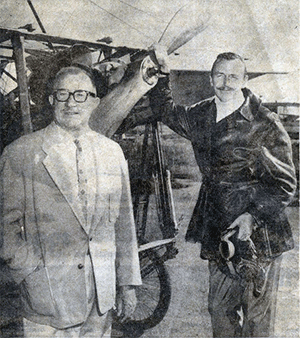 |
He modified the Mustangs for air racing. He was a three-time winner of the Bendix Trophy, flying one-way from Los Angeles to Cleveland. He won in 1946 (435.5MPH; 4:43:14), in 1947 (460.42MPH; 4:26:57.4) and in 1948 (447.98MPH; 4:33:48.7). He won $10,000 for each victory. Below, from The New York Times of August 31, 1946, Mantz is pictured emerging from his airplane at the conclusion of the 1946 event.
In 1961 Mantz joined forces with another major name in Hollywood aviation, Frank Tallman, right (b. April 17, 1919; d. April 15, 1978). Mantz was fatigued from the pressures of his businesses and wanted to share the effort and responsibility with his younger partner. They combined their fleets and their hangars and created TallMantz Aviation, Inc.
Tallman brought his collection of pre-1920s aircraft to their combined fleet, and Tallmantz Aviation continued to provide aircraft and pilots for movies and now television. A slide show of Tallmantz aircraft is at the link (YouTube). Following Tallman's death in 1978 the Tallmantz businesses dissolved and the vintage civil, military and camera aircraft were sold off and disbursed. Many were purchased by Kermit Weeks and live today at his Fantasy of Flight Museum in Florida.
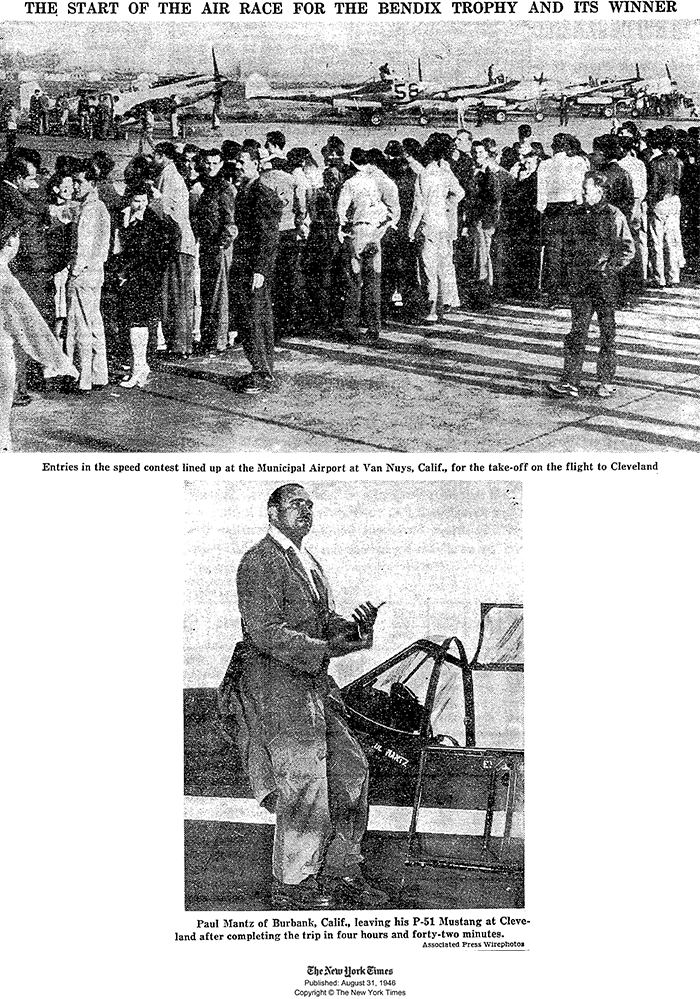 |
 |
Mantz was killed on July 8, 1965 while flying for the movie "Flight of the Phoenix." He came out of semi-retirement to fly the Phoenix P-1 for the film. The film, starring Jimmy Stewart, is a classic aviation movie. Mantz was performing flights for the camera with the Phoenix, a cobbled together aircraft that was the subject of the film. On his final pass the airplane's landing gear, actually skids, struck a hillock and the fuselage broke apart and cartwheeled, killing Mantz and seriously injuring a stuntman on board. You can find footage of the accident on YouTube.
Besides the photographs and news articles exhibited above, the San Diego Aerospace Museum (SDAM, left sidebar) holds a photo scrapbook compiled by Mantz. The cover for this artifact is shown at right, dated March 11, 1981, the date it was donated to the Museum by Mantz's wife. The contents, however, cover a fair in San Francisco during 1940.
Mantz flew with Transport pilot certificate T5011. He is buried at Costa Mesa, CA. His grave marker is below.
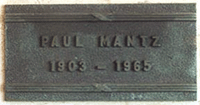 |
Mantz has a modest Web presence, with one family site devoted to his memory. At the link are many other links to online biographies of Mantz, film clips and photo galleries. In addition, The New York Times archives hold many articles about Mantz's business, racing history, relationship with Amelia Earhart's flights and other aspects of his flying life. His obituary, from The New York Times (NYT), July 9, 1965, is below.
 |
The New York Times further reported on January 11, 1967 the results of the official enquiry into the crash. Besides the marginal airworthiness of the aircraft, "The aeronautics board, in a report released yesterday, listed the probably causes of the accident as 'impaired efficiency and judgement of the pilot caused by the consumption of alcohol' and 'overload failure of the fuselage structure.'"
---o0o---
SPONSORED LINKS
THIS PAGE UPLOADED: 04/29/16 REVISED: 01/08/23
